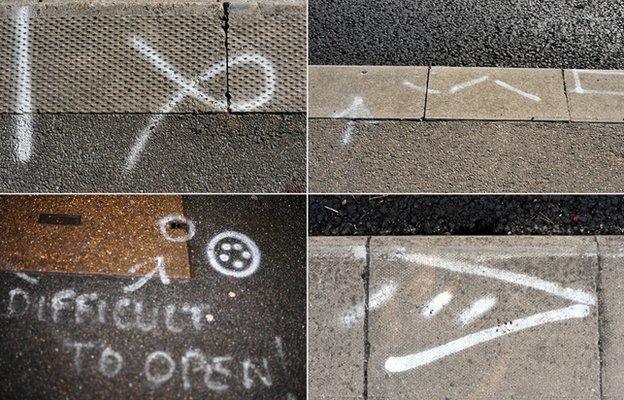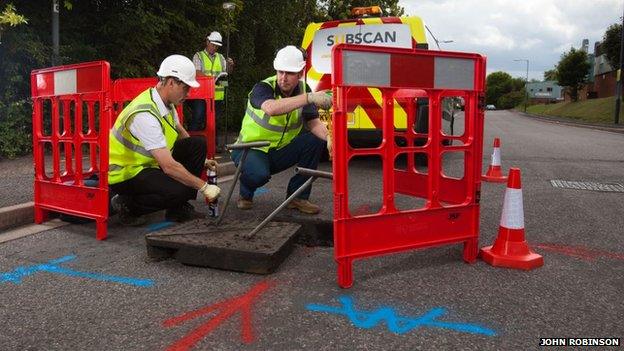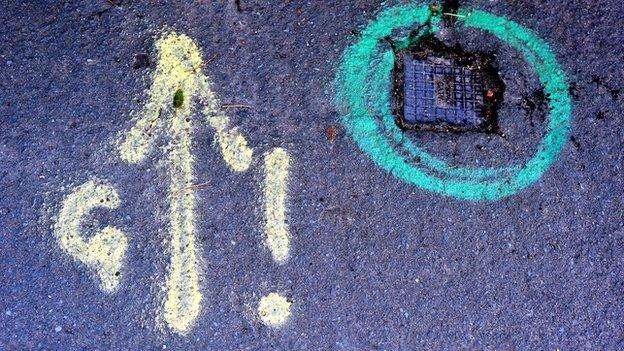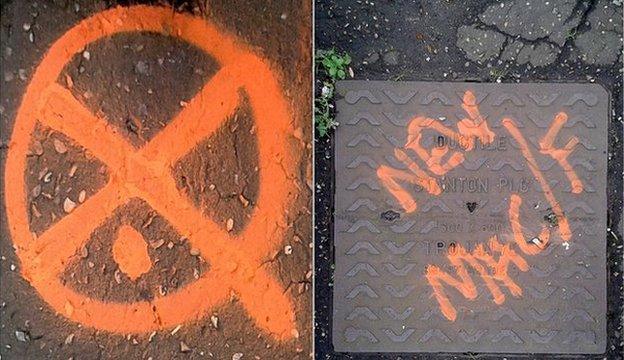What do those squiggles on the pavement actually mean?
- Published
.jpg)
Look down at British roads and pavements and there's often a slew of squiggles, dots and arrows, painted in a plethora of hues. But what do they actually mean?
In London alone, more than 50 different utility companies have the power to dig up the highway.
There are a lot of people who need to know exactly what lies beneath the ground, says Stephen Palmer, the chief executive of the Institute of Highways Engineers.
Mistakes are dangerous and costly. To offset such risks, a language has emerged that is spoken in spray paint. Its lexicon is numbers, lines and symbols. Its grammar is most definitely colour.
And once understood, this pavement patois - based entirely on convention rather than law - puts even a basic speaker in touch with a subterranean myriad of pipes and cables powering the ebbs and flows of modern existence.
Red
.jpg)
Used in warning signs the world over, red pavement paint denotes electricity. Thus red lines show where electricity cables run, says Kate Parkin, at UK Power Networks.
The numbers next to these red lines spell out either the distance to the kerb or the depth below ground (usually followed by a "d") while the letters L/V means "low voltage", H/V "high voltage" and S/L "street light service". All of the above are, needless to say, dangerous to anyone inadvertently interfering with them. If there are letters as well - such as UKPN in the image above - that will usually designate which power company the cables belong to (UK Power Network in this instance).
Eagle-eyed pavement watchers may sometimes see the letters SWA written on the road (as in red in the photograph at the top of the page). This shows the cable beneath the ground is steel-wire armoured (SWA). Companies need to "know where the cables or pipes are before they start digging", says Parkin.
White

White is the "sticky note" colour of the road and pavement marking world. From advice to measurements to instructions about what road markings should go where, white is the colour of general communication between the highways contractors.
When a road is resurfaced, for example, all the previous white or yellow markings in the street disappear. But the previous locations of these carriageway markings - whether they denote bus stop or keep clear zig-zag lines - will be noted in white on pavements to the side.
A "white line gang" will come along after the road surface has set and recreate the street markings, external as they previously were. "It saves someone having to set it all out again, it saves money," says Palmer.
So above at top left we have what appears to be the infinity symbol. This marks the start or finish of any particular road scheme. The arrow and zig-zag markings at top right show where the zig-zag lines (on this occasion on either side of a zebra crossing) in the road should start.
To the bottom right of the image above is what looks like the mouth of a crocodile with a single row of teeth. In fact, these markings show where a tapered hatched marking area should go. These are used to divide opposing flows of traffic - in this example around a traffic island.
White is also the colour of general communication between contractors. If a utility cover is tough to open, a white pavement "note" might be left saying so (see bottom left). The circular symbol indicates the number of cables inside a cable duct.
If there is a defect in the road or pavement, again, it might be marked. Palmer suggests that decoding what all the white markings mean can be difficult. "The contractors will sometimes use their own code - they know what they're talking about, but we don't."
White is also used for telecommunication companies like BT. A spokesman for BT said its contractors made their markings on the same day as any works so "as not to leave paint marks everywhere".
Blue

Blue markings tell us about the water mains which run beneath our feet
It should come as no surprise that the colour blue denotes water pipes. But it is often not the water companies who leave blue (or other colour) markings.
Increasingly, they are the work of dedicated "locating companies" employed by contractors and utility firms to create maps of exactly what lies beneath the surface before works are carried out.

The markings on roads are painted after the various underground utility lines have been detected
John Robinson, managing director of Subscan Technology, says various methods including ground radar are used to work out where various utility lines lay.
Once located, they will be marked on the ground using biodegradable paint and formatted onto a computer file for the relevant client.
"There's a whole infrastructure down there," says Robinson. "People don't usually realise what's under their feet."
Yellow
.jpg)
Yellow lines mean parking restrictions, right? Well not when they are on the pavement. Pavement yellow is the paint preserve of all things gas.
Sometimes there will be little more than a splodge of yellow on a metal-plated gas cover. But sometimes there will be a wealth of information offered about the gas lines beneath the ground.
You may see signs referring to LP gas for example. This does not mean there's liquid petroleum gas running beneath the ground. Instead, LP refers to low pressure. By the same token, MP and HP refer to medium and high pressure respectively.

Authors in yellow may also leave information about the depths and lengths of pipes, and whether there is anything contractors need to be aware of - such as a 90-degree elbow on a gas pipe (shown top of this section) which would be marked PE 90 or 90 PE. The image immediately above shows the location of a gas stopcock cover.
Green

A growing hue in the pavement-marking business is green, the colour of cable communications, which includes town and city CCTV networks and cable television lines.
Virgin Media, with its extensive fibre optic network, produces the most green pavement markings, according to Robinson, who is one of a number of experts to help draft a new British Standards Institution specification for underground utility detection, external.
As with other utilities, these pipes can sometimes contain a number of ducts. The number of ducts are represented as dots within circles, says Robinson. With other utilities, the dots in circle symbol can represent the number of cables within a single duct.
Others

Even experts like Palmer say some of the markings left on pavements resemble "hieroglyphs". Take a bright orange circle with a cross through it and a single dot in the lower quadrant. Pagan symbol? Buried treasure?
Far from it. In fact such an unusual looking marking (shown above left) is nothing more than the local authority setting out where it wants a new lamp post.
The image on the right is far more obvious - and a relatively common marking on the pavement. MHC stands for manhole cover and the F means frame. The author is simply recording that the whole iron cover and frame needs replacing.
But while some local authorities use orange for their markings, some use other colours such as mauve. That regional variation reflects a larger issue when it comes to pavement markings.
All of the colours cited above are based entirely on convention. None of it is enshrined in law. "There is no official designation," says Robinson. "There are no official colour schemes. The various players have never been able to get everybody to agree."
Follow @BBCNewsMagazine, external on Twitter and on Facebook, external